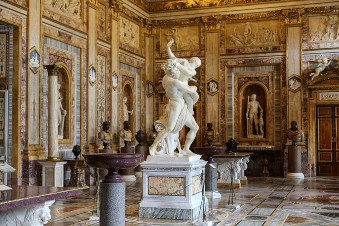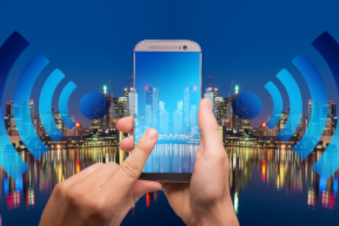The application of IoT technologies in museums has many advantages,
both for visitors and curators.
How can a museum leverage technology to improve its offerings?
Beacons transform museums and cultural spaces into multimedia and immersive environments
Beacons make museums and cultural
spaces interactive.
Just install beacons by placing them near the paintings: when a visitor approaches any painting,
the beacon recognizes the proximity and provides multimedia contents on that painting (videos, music, information about the author, ect).
In this way, visiting an exhibition or a museum becomes an integrated and immersive experience.
The goal is to provide an audio guide for the visit to the museum, available directly on smartphones or tablet and listenable at any time.
This technology has obvious advantages for visitors, but also for museum managers, who will no longer have to incur management and maintenance hardware costs of traditional
audio guides. In fact, the contents associated with each beacon can be updated and modified very simply and in real time.
A data collection source for curators
- Beacons can also be used as sources for data collection:
- • to evaluate, for example, the popularity of an exhibition or a work of art based on the "stopping time" of visitors who
stop to admire it, or see which spaces are most frequently visited by users and which works of art attract or generate the most attention;
- • to obtain detailed information on the target audience, collecting data on their behavior and interests.
Other Applications
- • Observation of visitor behavior to optimize the trend of crowds, minimize costs, increase the availability of salable tickets
- • Tools for check-in at the museum entrance (eliminating paper tickets, queues, change problems, etc.)
- • Optimization of the visitor experience. Improve the museum visit experience, for example by preventing the rooms from becoming overcrowded
- • Visits in safety thanks to the possibility of real-time observation of compliance with social distancing rules
- • Maintaining the integrity of the works and historic buildings: a smaller fluctuation in the number of people per room minimizes
changes in humidity that can affect the works in the long run
Furthermore, the installation of a beacon does not require any type of structural intervention, thus safeguarding the integrity of historic buildings.
New opportunities: pay-per-view
A new way of visiting could be introduced, charging visitors only for the art they look.
The opportunity to pay only for what they see could be given to the visitors, and if the total number of views of
a visitor exceeds a certain amount, the visitor's pay-per-view ticket will automatically switch to the normal ticket, so that they never pay again
of the maximum cost foreseen by the ticket.
A fundamental advantage of this mode is that it would also be possible to attract people who want to see only a few pieces, for study or curiosity,
but are discouraged from doing so by the price of the ticket.
A pay-per-view option could bring more visitors to the smart museum, potentially also increasing the income streams obtained through
sales of restaurants and souvenirs.
Beacons and social media
Beacons can be designed both to make the museum communicate with its visitors, and to communicate with those who pass nearby (potential visitors).
Facebook has integrated the "Place Tips" functionality, and following this integration, some places in New York have been integrated with beacons.
One of these is the Metropolitan which has made it possible to install two beacons inside that have the function of communicating with the smartphones of Facebook users in the
near the structure: in this way those who are nearby and use the "Place Tips" service will receive a notification on their Facebook profile,
viewing suggestions, reviews/suggestions from friends, photos and videos relating to the Museum.
Some case studies:
Galleria Borghese in Rome
Galleria Borghese has resorted to beacons to optimize the flow of visitors, managing to increase the availability of salable tickets by 20% per shift and an increase of about 10% in daily visitors. It has also managed to reduce the queue at the entrance and the congestion of people in every room (this means avoiding gatherings, which increase the risk of transmission of Covid-19 and reduce the quality of the customer experience, and minimize the swings of the thermohygrometric parameters which in the long term can damage the works on display and the decorations of the rooms).
Museo dell'Opera del Duomo in Florence
The Museo dell'opera del Duomo has provided an audio guide for the visit to the museum, available directly in its own smartphone or tablet through application, usable by every type of user.
Civic Museums of Palazzo Farnese in Piacenza
The Civic Museums of Palazzo Farnese have developed an application using beacons technology. This works as an audio guide and GPS inside the museum: when you approach a painting, the card dedicated to it appears on the screen without having to manually interact with the phone, and there is the possibility of creating a personal itinerary at the beginning of the tour, so that the application indicates the way to visit only the selected works.
Rubens Art Museum in Belgium
Here the beacons form a sort of GPS system inside the museum through which visitors can follow thematic and personalized itineraries within the exhibitions.
Philips Museum in the Netherlands
Through the beacons, a multimedia game called “Eureka” has been developed. The game includes a digital "treasure hunt": the beacons, scattered around the rooms of the museum, interact with iPads delivered to the participants who are involved in quizzes, puzzles and games.
New Museum, USA
The New Museum in New York, on the occasion of the International Landmine Awareness Day announced by the ONU on April 4, hosted an exhibition that used lighthouses to simulate a virtual minefield. When a person gets too close to a transmitter, the beacon will act like a mine, simulating an explosion with a loud noise transmitted into the visitor's headphones. Following the explosion, the audio testimony of a victim of a mine explosion will automatically play.
Do you want to find out if BlueUp solutions can help you? Contact us to find out more! 😊
Related content



